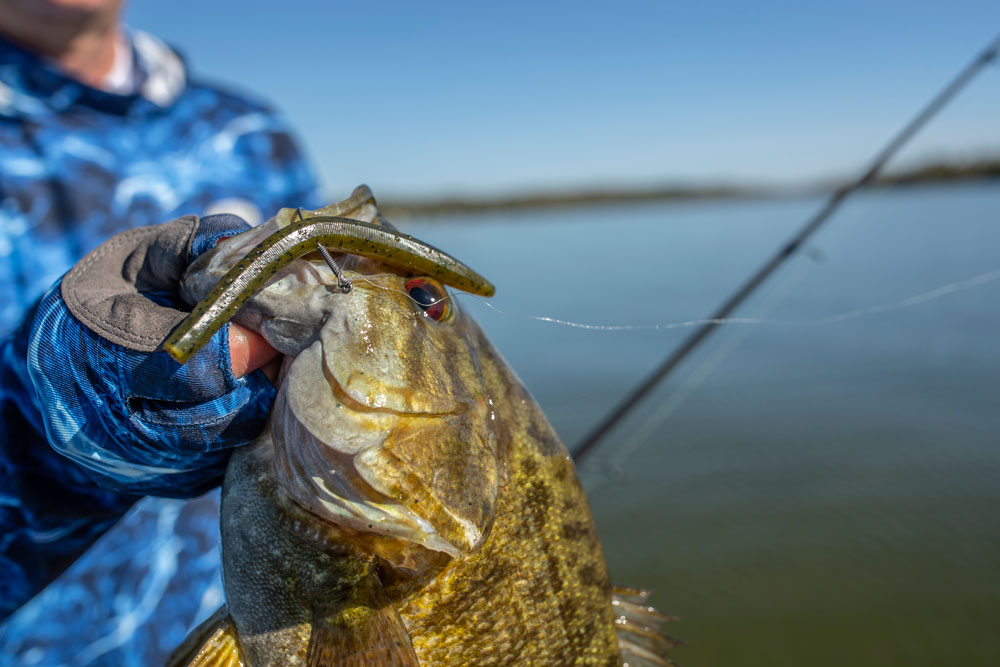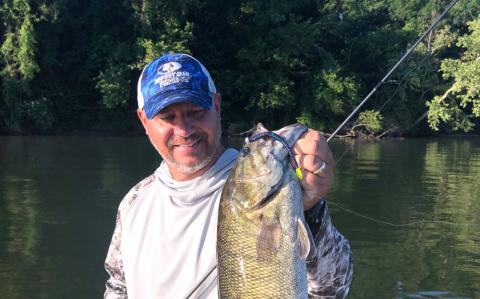provided by John Phillips
One of the best big smallmouth bass waters is the Tennessee River, especially the southern half that runs through north Alabama, west Mississippi and south Tennessee. The two lakes that get the most publicity and produce the biggest smallmouths are Pickwick and Wilson lakes. However, these two lakes not only produce great smallmouth fishing, but equally as good, if not better, largemouth, spotted, hybrid saltwater and striped bass fishing and catfishing. Brad Whitehead of Muscle Shoals, Alabama, guides for smallmouths and other fish. To learn more about Whitehead, visit his Facebook page.

Underwater mussel shell banks are a great place to catch smallmouths at Pickwick. We drift over them with the current and fish live shad minnows. But another fishability feature that Pickwick has are the old underwater barge canals and places where the water from the Tennessee River has been diverted before the building of the dam at Pickwick. Many of these rock piles may be an acre wide and may break the current. The smallmouths may hold behind those rocks.
The barge canals and the diversion canals are great places to fish for smallmouths with artificial lures. The jig and pig is a popular lure, as well as the new little Ned Rigs, and swimbaits can produce by an angler casting a swim bait upcurrent and reeling it in downcurrent along those rocks.
My son, Nathan, who is a high-school competition bass fisherman, likes to fish a 6-inch Sexy Spoon, a flutter spoon that’s made by Strike King. He also fishes a number of deep-diving crankbaits along those rocks and stumps on the old river channel. The bass in the summer months on Pickwick Lake often will pull out of the shallow water and concentrate on those deep river ledges at 20-30 feet deep. When you find a school of bass holding on those ledges, oftentimes the schools will be mixed up with smallmouths, largemouths, spotted bass and occasionally stripes, hybrids and white bass in the same school. To pinpoint those deep-ledge fish, you really have to rely on your electronics to show you the fish. Another thing that is different about Pickwick from Wilson, is Pickwick has a good amount of grass in it. Now, you won’t catch a lot of smallmouths around this grass, but you can catch a good number of largemouths holding on the edge of it because the bait fish are crammed in that grass.
Another technique for catching good-size smallmouths is night fishing during the summer months. I primarily fish with my son Nathan on Wilson Lake at night. One of the reasons we like to fish Wilson at night is because there are rarely any boats, skiers or jet skiers on the water then. The water is calm, the turbines are usually not generating, and when we fish close to the dam, there are numbers of lights mounted under the piers and docks, which attract shad. Also, those lights attract both largemouths and smallmouths, and we’ll usually cast rubber flukes under the piers and twitch them back toward the lights and catch some really nice bass. When we are specifically fishing for smallmouths, we’ll often use black-and-white Slider Worms and heads on spinning rods.
We also do really well fishing spinner baits at night, and we prefer Colorado blades instead of willow-leaf blades on our spinner baits. Those Colorado blades put out more vibrations than the willow-leaf blades do. If you fish below Wilson Dam at night, and there’s any current coming from the dam, the smallmouths will crush those spinner baits. Black-and-red, purple-and-red and any kind of dark skirt seem to produce the best. In a 4–5 hour night fishing trip, you’ll probably catch 3–4 nice smallmouths and 8-10 largemouths fishing below Wheeler Dam on Wilson Lake. Catching 13-14 bass in a 4-hour night trip is easy.






























